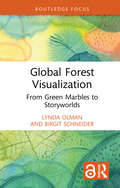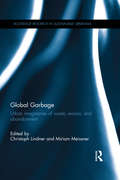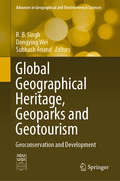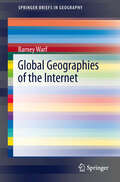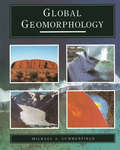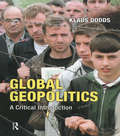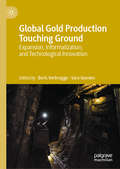- Table View
- List View
Global Food Systems, Diets, and Nutrition: Linking Science, Economics, and Policy (Palgrave Studies in Agricultural Economics and Food Policy)
by Claire Davis Jessica FanzoEnsuring optimal diets and nutrition for the global population is a grand challenge fraught with many contentious issues. To achieve food security for all and protect health, we need functional, equitable, and sustainable food systems. Food systems are highly complex networks of individuals and institutions that depend on governance and policy leadership. This book explains how interconnected food systems and policies affect diets and nutrition in high-, middle-, and low-income countries. In tandem with food policy, food systems determine the availability, affordability, and nutritional quality of the food supply, which influences the diets that people are willing and able to consume. Readers will become familiar with both domestic and international food policy processes and actors, and they will be able to critically analyze and debate how policy and science affect diet and nutrition outcomes.
Global Forest Carbon: Policy, Economics and Finance (The Earthscan Forest Library)
by Runsheng YinThis book addresses the major policy, economic and financial issues encountered in global forest carbon.The global forest sector is expected to play a major role in achieving the Paris Agreement’s temperature targets. Therefore, there is an urgent need to explore practical and promising solutions to the challenges facing carbon accounting and policy assessment as the global community undertakes forest sector actions—including the widely known REDD+ initiative. This book demonstrates how vital it is that we identify appropriate perspectives and formulate approaches to address these challenges in an integrated and effective manner. In doing so, it addresses many of the major issues, including the differential potentials for carbon sequestration within various forest ecosystems as well as for storage within a variety of harvested wood products, the joint production of timber and carbon, and the measurement and impact of forest carbon offsets and credits, results-based payments, and other nationally determined contributions centered differences as well. The book examines regional and country-level case studies from across the world and draws on the author's decades of experience working on forest policy and with the forest sector. Overall, this book highlights the technical and policy issues regarding forest sector carbon emission and removal to build useful perspectives, frameworks, and methods for addressing these issues successfully in the future. It advances the knowledge frontiers of global forest carbon policy, economics and finance as well as the ability to assess the effectiveness, efficiency, and equity of forest climate solutions.This book is essential reading for professionals and policymakers working at the intersection of forest policy, carbon storage and climate change, as well as students and researchers in the fields of forestry, natural resource management, climate change and nature-based solutions.
Global Forest Carbon: Policy, Economics and Finance (The Earthscan Forest Library)
by Runsheng YinThis book addresses the major policy, economic and financial issues encountered in global forest carbon.The global forest sector is expected to play a major role in achieving the Paris Agreement’s temperature targets. Therefore, there is an urgent need to explore practical and promising solutions to the challenges facing carbon accounting and policy assessment as the global community undertakes forest sector actions—including the widely known REDD+ initiative. This book demonstrates how vital it is that we identify appropriate perspectives and formulate approaches to address these challenges in an integrated and effective manner. In doing so, it addresses many of the major issues, including the differential potentials for carbon sequestration within various forest ecosystems as well as for storage within a variety of harvested wood products, the joint production of timber and carbon, and the measurement and impact of forest carbon offsets and credits, results-based payments, and other nationally determined contributions centered differences as well. The book examines regional and country-level case studies from across the world and draws on the author's decades of experience working on forest policy and with the forest sector. Overall, this book highlights the technical and policy issues regarding forest sector carbon emission and removal to build useful perspectives, frameworks, and methods for addressing these issues successfully in the future. It advances the knowledge frontiers of global forest carbon policy, economics and finance as well as the ability to assess the effectiveness, efficiency, and equity of forest climate solutions.This book is essential reading for professionals and policymakers working at the intersection of forest policy, carbon storage and climate change, as well as students and researchers in the fields of forestry, natural resource management, climate change and nature-based solutions.
Global Forest Governance and Climate Change: Interrogating Representation, Participation, and Decentralization (Palgrave Studies in Natural Resource Management)
by Emmanuel O. NuesiriThis edited collection assesses governance in forestry programmes and projects, including REDD+ governance. It examines political representation, participation and decentralisation in forest governance, providing insight as to how forest governance arrangements can be responsive to the socio-economic interests of local people and communities who live adjacent to and depend on forests.Global Forest Governance and Climate Change argues that inclusive complementary representation of local communities is required for strong participatory processes and democratic decentralisation of forest governance. Responsiveness to local people’s socio-economic interests in forestry initiatives require paying attention to not just the hosting of participatory meetings and activities, but also to the full cast of appointed, self-authorized, and elected representative agents that stand, speak, and act for local people. This book will be of interest to students and academics across the fields of climate change governance, forestry, development studies, and political economy. It will also be a useful resource for policy makers and practitioners responsible for forestry and climate change initiatives.
Global Forest Governance and Climate Change: Interrogating Representation, Participation, and Decentralization (Palgrave Studies in Natural Resource Management)
by Emmanuel O. NuesiriThis edited collection assesses governance in forestry programmes and projects, including REDD+ governance. It examines political representation, participation and decentralisation in forest governance, providing insight as to how forest governance arrangements can be responsive to the socio-economic interests of local people and communities who live adjacent to and depend on forests.Global Forest Governance and Climate Change argues that inclusive complementary representation of local communities is required for strong participatory processes and democratic decentralisation of forest governance. Responsiveness to local people’s socio-economic interests in forestry initiatives require paying attention to not just the hosting of participatory meetings and activities, but also to the full cast of appointed, self-authorized, and elected representative agents that stand, speak, and act for local people. This book will be of interest to students and academics across the fields of climate change governance, forestry, development studies, and political economy. It will also be a useful resource for policy makers and practitioners responsible for forestry and climate change initiatives.
The Global Forest Sector: Changes, Practices, and Prospects
by Rajat Panwar Eric Hansen Richard VloskyChanges in production, demand, supply, and trade patterns; the impact of green building and bioenergy on industry practices and policy infrastructure; and new economies with production advantages and large consumption bases all present challenges and opportunities in the forest sector. With contributions from leading experts in academia and profess
Global Forest Visualization: From Green Marbles to Storyworlds (Routledge Focus on Environment and Sustainability)
by Lynda Olman Birgit SchneiderThis book project examines global forest monitoring as a means to understand the promises and problems of global visualization for climate management.Specifically, the book focuses on Global Forest Watch, the most developed and widely available forest-monitoring platform, created in 1997 by the World Resource Institute. Forest maps are always political as they visualize power relations and form the grid within which forests become commodities. This dislocation of the idea of the forest from its literal roots in the ground has generated problems for forest visualization efforts designed to empower local communities. This book takes a critical humanistic approach to this problem, combining methods from the fields of rhetoric and media studies to suggest solutions to these problems for designers and users of platforms like the Global Forest Watch. To explain why global views of forests can be disempowering, the book relies on biopolitical and rhetorical theories of panopticism and how these views unfold a different violence on different regions of the Earth in relation to colonial history. Using this theoretical framework, the book explains the historical process by which forests came to be classified, quantified, and mapped on a global scale. Interviews with end-users of global forest visualization platforms reveal if and how these platforms support local action. Lastly, the book provides rhetorical solutions to articulate global and local views of forests without reducing one view to the other. These solutions involve looking to forests themselves for clues about how to generate more broadly effective and resilient visualizations.This book will be of great interest to students and scholars of forest studies, climate change, science communication, visualization studies, environmental communication, and environmental conservation.The Open Access version of this book, available at http://www.taylorfrancis.com, has been made available under a Creative Commons [Attribution-Non Commercial-No Derivatives (CC-BY-NC-ND)] 4.0 license.
Global Forest Visualization: From Green Marbles to Storyworlds (Routledge Focus on Environment and Sustainability)
by Lynda Olman Birgit SchneiderThis book project examines global forest monitoring as a means to understand the promises and problems of global visualization for climate management.Specifically, the book focuses on Global Forest Watch, the most developed and widely available forest-monitoring platform, created in 1997 by the World Resource Institute. Forest maps are always political as they visualize power relations and form the grid within which forests become commodities. This dislocation of the idea of the forest from its literal roots in the ground has generated problems for forest visualization efforts designed to empower local communities. This book takes a critical humanistic approach to this problem, combining methods from the fields of rhetoric and media studies to suggest solutions to these problems for designers and users of platforms like the Global Forest Watch. To explain why global views of forests can be disempowering, the book relies on biopolitical and rhetorical theories of panopticism and how these views unfold a different violence on different regions of the Earth in relation to colonial history. Using this theoretical framework, the book explains the historical process by which forests came to be classified, quantified, and mapped on a global scale. Interviews with end-users of global forest visualization platforms reveal if and how these platforms support local action. Lastly, the book provides rhetorical solutions to articulate global and local views of forests without reducing one view to the other. These solutions involve looking to forests themselves for clues about how to generate more broadly effective and resilient visualizations.This book will be of great interest to students and scholars of forest studies, climate change, science communication, visualization studies, environmental communication, and environmental conservation.The Open Access version of this book, available at http://www.taylorfrancis.com, has been made available under a Creative Commons [Attribution-Non Commercial-No Derivatives (CC-BY-NC-ND)] 4.0 license.
Global Garbage: Urban imaginaries of waste, excess, and abandonment (Routledge Research in Sustainable Urbanism)
by Christoph Lindner Miriam MeissnerGlobal Garbage examines the ways in which garbage, in its diverse forms, is being produced, managed, experienced, imagined, circulated, concealed, and aestheticized in contemporary urban environments and across different creative and cultural practices. The book explores the increasingly complex relationship between globalization and garbage in locations such as Beirut, Detroit, Hong Kong, London, Los Angeles, Manchester, Naples, Paris, Rio de Janeiro and Tehran. In particular, the book examines how, and under what conditions, contemporary imaginaries of excess, waste, and abandonment perpetuate – but also sometimes counter – the imbalances of power that are frequently associated with the global metropolitan condition. This interdisciplinary collection will appeal to the fields of anthropology, architecture, film and media studies, geography, urban studies, sociology, and cultural analysis.
Global Garbage: Urban imaginaries of waste, excess, and abandonment (Routledge Research in Sustainable Urbanism)
by Christoph Lindner Miriam MeissnerGlobal Garbage examines the ways in which garbage, in its diverse forms, is being produced, managed, experienced, imagined, circulated, concealed, and aestheticized in contemporary urban environments and across different creative and cultural practices. The book explores the increasingly complex relationship between globalization and garbage in locations such as Beirut, Detroit, Hong Kong, London, Los Angeles, Manchester, Naples, Paris, Rio de Janeiro and Tehran. In particular, the book examines how, and under what conditions, contemporary imaginaries of excess, waste, and abandonment perpetuate – but also sometimes counter – the imbalances of power that are frequently associated with the global metropolitan condition. This interdisciplinary collection will appeal to the fields of anthropology, architecture, film and media studies, geography, urban studies, sociology, and cultural analysis.
Global Geodetic Observing System: Meeting the Requirements of a Global Society on a Changing Planet in 2020
by Hans-Peter Plag Michael PearlmanThe Global Geodetic Observing System (GGOS) has been established by the Int- national Association of Geodesy (IAG) in order to integrate the three fundamental areas of geodesy, so as to monitor geodetic parameters and their temporal varia- ?9 tions, in a global reference frame with a target relative accuracy of 10 or b- ter. These areas, often called ‘pillars’, deal with the determination and evolution of (a) the Earth’s geometry (topography, bathymetry, ice surface, sea level), (b) the Earth’s rotation and orientation (polar motion, rotation rate, nutation, etc. ), and (c) the Earth’s gravity eld (gravity, geoid). Therefore, Earth Observation on a global scale is at the heart of GGOS’s activities, which contributes to Global Change - search through the monitoring, as well as the modeling, of dynamic Earth processes such as, for example, mass and angular momentum exchanges, mass transport and ocean circulation, and changes in sea, land and ice surfaces. To achieve such an - bitious goal, GGOS relies on an integrated network of current and future terrestrial, airborne and satellite systems and technologies. These include: various positioning, navigation, remote sensing and dedicated gravity and altimetry satellite missions; global ground networks of VLBI, SLR, DORIS, GNSS and absolute and relative gravity stations; and airborne gravity, mapping and remote sensing systems.
Global Geographical Heritage, Geoparks and Geotourism: Geoconservation and Development (Advances in Geographical and Environmental Sciences)
by R. B. Singh Dongying Wei Subhash AnandThis book explores the geographical, geomorphological, ecological, touristic and socioeconomic aspects of natural heritage, argues for the dynamic conservation of that heritage and explains its key characteristics, promotion, conservation and management to achieve sustainable development goals. Emerging concepts such as geodiversity, geographical heritage sites, geomonuments, geoparks and geotourism are increasingly being used by conservationists. At present, the development of geoparks is a major global theme involving the application of geosciences to promote the inclusive growth of society and the protection and conservation of our unique geoheritage. Currently, there are 147 UNESCO global geoparks across 41 countries, in addition to a number of national-level geoparks. Pursuing a holistic approach towards such sites will sensitise the general public to the need for geoconservation of significant geosites and promote it through geotourism. It is a crucial issue, as various countries around the world are eager to develop their geoparks and are working for the conservation of geoheritage sites at the national level. This unique book gathers contributions from 15 countries in the form of case studies analysing the realities on of geographical heritage, geoparks and geotourism. The respective chapters address the role of geoparks as essential tools for education, recreation and nature conservation. Given its scope, the book offers a valuable guide for geoscientists, planners, policymakers, civil society and anyone concerned about the conservation of geoheritage sites and geoparks for a sustainable future Earth.
Global Geographies of the Internet (SpringerBriefs in Geography)
by Barney WarfToday, roughly 2 billion people use the internet, and its applications have flourished in number and importance. This volume will examine the growth and geography of the internet from a political economy perspective. Its central motivation is to illustrate that cyberspace does not exist in some aspatial void, but is deeply rooted in national and local political and cultural contexts. Toward that end, it will invoke a few major theorists of cyberspace, but apply their perspectives in terms that are accessible to readers with no familiarity with them. Beyond summaries of the infrastructure that makes the internet possible and global distributions of users, it delves into issues such as the digital divide to emphasize the inequalities that accompany the growth of cyberspace. It also addresses internet censorship, e-commerce, and e-government, issues that have received remarkably little scholarly attention, particularly from a spatial perspective. Throughout, it demonstrates that in cyberspace, place matters, so that no comprehensive understanding of the internet can be achieved without considering how it is embedded within, and in turn changes, local institutional and political contexts. Thus the book rebuts simplistic “death of distance” views or those that assert there is, or can be, a “one-size-fits-all, cookie-cutter” model of the internet applicable to all times and places.
Global Geometry and Mathematical Physics: Lectures given at the 2nd Session of the Centro Internazionale Matematico Estivo (C.I.M.E.) held at Montecatini Terme, Italy, July 4-12, 1988 (Lecture Notes in Mathematics #1451)
by L. Alvarez-Gaume E. Arbarello C. De Concini N.J. HitchinThe Global Geometry of Turbulence: Impact of Nonlinear Dynamics (Nato Science Series B: #268)
by Javier JiménezThe aim of this Advanced Research Workshop was to bring together Physicists, Applied Mathematicians and Fluid Dynamicists, including very specially experimentalists, to review the available knowledge on the global structural aspects of turbulent flows, with an especial emphasis on open systems, and to try to reach a consensus on their possible relationship to recent advances in the understanding of the behaviour of low dimensional dynamical systems and amplitude equations. A lot has been learned during recent years on the non-equilibrium behaviour of low dimen sional dynamical systems, including some fluid flows (Rayleigh-Benard, Taylor-Couette, etc. ). These are mostly closed flows and many of the global structural features of the low dimensional systems have been observed in them, including chaotic behaviour, period doubling, intermit tency, etc. . It has also been shown that some of these flows are intrinsically low dimensional, which accounts for much of the observed similarities. Open flows seem to be different, and experimental observations point to an intrinsic high dimensionality. However, some of the tran sitional features of the low dimensional systems have been observed in them, specially in the intermittent behaviour of subcritical flows (pipes, channels, boundary layers with suction, etc. ), and in the large scale geometry of coherent structures of free shear flows (mixing layers, jets and wakes).
Global Geomorphology
by Michael A. SummerfieldThe plate tectonics revolution in the earth sciences has provided a valuable new framework for understanding long-term landform development.This innovative text provides a comprehensive introduction to the subject of global geomorphology, with the emphasis placed on large-scale processes and phenomena. Integrating global tectonics into the study of landforms and incorporating planetary geomorphology as a major component the author discusses the impact of climatic change and the role of catastrophic events on landform genesis and includes a comprehensive study of surface geomorphic processes.
Global Geomorphology
by Michael A. SummerfieldThe plate tectonics revolution in the earth sciences has provided a valuable new framework for understanding long-term landform development.This innovative text provides a comprehensive introduction to the subject of global geomorphology, with the emphasis placed on large-scale processes and phenomena. Integrating global tectonics into the study of landforms and incorporating planetary geomorphology as a major component the author discusses the impact of climatic change and the role of catastrophic events on landform genesis and includes a comprehensive study of surface geomorphic processes.
Global Geopolitics: A Critical Introduction
by Klaus J. DoddsEmploying thematic investigation and illustrated through case studies, Dodds explores how global politics is imagined and practised by countries such as the US and other organisations including Greenpeace, the IMF and CNN International.In addition, the author discusses how issues such as environmental degradation, terror networks, anti-globalisation protests and North-South relations challenge, consolidate and subvert the existing international political system.
Global Geopolitics: A Critical Introduction
by Klaus J. DoddsEmploying thematic investigation and illustrated through case studies, Dodds explores how global politics is imagined and practised by countries such as the US and other organisations including Greenpeace, the IMF and CNN International.In addition, the author discusses how issues such as environmental degradation, terror networks, anti-globalisation protests and North-South relations challenge, consolidate and subvert the existing international political system.
Global Gold Production Touching Ground: Expansion, Informalization, and Technological Innovation
by Boris Verbrugge Sara GeenenIn recent decades, gold mining has moved into increasingly remote corners of the globe. Aside from the expansion of industrial gold mining, many countries have simultaneously witnessed an expansion of labor-intensive and predominantly informal artisanal and small-scale gold mining. Both trends are usually studied in isolation, which contributes to a dominant image of a dual gold mining economy. Counteracting this dominant view, this volume adopts a global perspective, and demonstrates that both industrial gold mining and artisanal and small-scale gold mining are functionally integrated into a global gold production system. It couples an analysis of structural trends in global gold production (expansion, informalization, and technological innovation) to twelve country case studies that detail how global gold production becomes embedded in institutional and ecological structures.
Global Governance and Rules for the Post-2015 Era: Addressing Emerging Issues in the Global Environment (The United Nations Series on Development)
by José Antonio Alonso José Antonio OcampoAttention is increasingly being paid to the conceptualization of the sustainable development agenda that should guide global development efforts beyond 2015. New trends are shaping the international environment, suggesting that the world emerging from the recent economic and financial crisis will probably be very different from the one we have known so far. The emerging issues demand new concerted responses and new international efforts, which will have to be framed by new rules and more democratic and inclusive mechanisms of global governance.Global Governance and Rules for the Post 2015 Era provides a unique assessment of global rules and governance, a reflection of how global rules have been shaping development experiences and outcomes, an identification of the shortcomings of current global governance mechanisms and innovative suggestions for reforming and improving them. The various chapters analyse whether current rules and governance structures enables the building of effective responses against international problems and promote a fair distribution of development opportunities among countries. This book is a timely contribution to the discussions on a new global development agenda undertaken under the leadership of the United Nations. It reflects the outcome of a research programme by a group of independent development experts brought together by the United Nations Committee for Development Policy (CDP), a subsidiary body of the Economic and Social Council. It will be of interest to policymakers worldwide, experts of international agencies, scholars, students and the wider public.
The Global Governance of Climate Change: G7, G20, and UN Leadership (Global Environmental Governance)
by John J. Kirton Ella KokotsisClimate change control has risen to the top of the international agenda. Failed efforts, centred in the United Nations, to allocate responsibility have resulted in a challenge now reaching crisis stage. John J. Kirton and Ella Kokotsis analyse the generation and effectiveness of four decades of intergovernmental regimes for controlling global climate change. Informed by international relations theories and critical of the prevailing UN approach, Kirton and Kokotsis trace the global governance of climate change from its 1970s origins to the present and demonstrate the effectiveness of the plurilateral summit alternative grounded in the G7/8 and the G20. Topics covered include: - G7/8 and UN competition and convergence on governing climate change - Kyoto obligations and the post-Kyoto regime - The role of the G7/8 and G20 in generating a regime beyond Kyoto - Projections of and prescriptions for an effective global climate change control regime for the twenty-first century. This topical book synthesizes a rich array of empirical data, including new interview and documentary material about G7/8 and G20 governance of climate change, and makes a valuable contribution to understanding the dynamics of governing climate change. It will appeal to scholars, researchers, and policy makers interested in the dynamics behind governance processes within the intergovernmental realm.
The Global Governance of Climate Change: G7, G20, and UN Leadership (Global Environmental Governance)
by John J. Kirton Ella KokotsisClimate change control has risen to the top of the international agenda. Failed efforts, centred in the United Nations, to allocate responsibility have resulted in a challenge now reaching crisis stage. John J. Kirton and Ella Kokotsis analyse the generation and effectiveness of four decades of intergovernmental regimes for controlling global climate change. Informed by international relations theories and critical of the prevailing UN approach, Kirton and Kokotsis trace the global governance of climate change from its 1970s origins to the present and demonstrate the effectiveness of the plurilateral summit alternative grounded in the G7/8 and the G20. Topics covered include: - G7/8 and UN competition and convergence on governing climate change - Kyoto obligations and the post-Kyoto regime - The role of the G7/8 and G20 in generating a regime beyond Kyoto - Projections of and prescriptions for an effective global climate change control regime for the twenty-first century. This topical book synthesizes a rich array of empirical data, including new interview and documentary material about G7/8 and G20 governance of climate change, and makes a valuable contribution to understanding the dynamics of governing climate change. It will appeal to scholars, researchers, and policy makers interested in the dynamics behind governance processes within the intergovernmental realm.
Global Governance of Genetic Resources: Access and Benefit Sharing after the Nagoya Protocol (Routledge Research in Global Environmental Governance)
by Sebastian Oberthür G. Kristin RosendalThis book analyses the status and prospects of the global governance of Access Benefit Sharing (ABS) in the aftermath of 2010’s Nagoya Protocol to the Convention on Biological Diversity (CBD). The CBD’s initial 1992 framework of global ABS governance established the objective of sharing the benefits arising from the use of genetic resources fairly between countries and communities. Since then, ABS has been a contested issue in international politics – not least due to the failure of effective implementation of the original CBD framework. The Nagoya Protocol therefore aims to improve and enhance this framework. Compared to the slow rate of progress on climate change, it has been considered a major achievement of global environmental governance, but it has also been coined a ‘masterpiece of ambiguity’. This book analyses the role of a variety of actors in the emergence of the Nagoya Protocol and provides an up-to-date assessment of the core features of the architecture of global ABS governance. This book offers a central resource regarding ABS governance for those working on and interested in global environmental governance. This is achieved by focusing on two broad themes of the wider research agenda on global environmental governance, namely architecture and agency. Furthermore, individual chapter contributions relate and link ABS governance to other prominent debates in the field, such as institutional complexes, compliance, market-based approaches, EU leadership, the role of small states, the role of non-state actors and more. Partly due to its seeming technical complexity, ABS governance has so far not been at the centre of attention of scholars and practitioners of global environmental governance. In this book, care is taken to provide an accessible account of key functional features of the governance system which enables non-specialists to gain a grasp on the main issues involved, allowing the issue of ABS governance to move centre-stage and be more fully recognised in discussions on global environmental governance.
Global Governance of Genetic Resources: Access and Benefit Sharing after the Nagoya Protocol (Routledge Research in Global Environmental Governance)
by Sebastian Oberthür G. Kristin RosendalThis book analyses the status and prospects of the global governance of Access Benefit Sharing (ABS) in the aftermath of 2010’s Nagoya Protocol to the Convention on Biological Diversity (CBD). The CBD’s initial 1992 framework of global ABS governance established the objective of sharing the benefits arising from the use of genetic resources fairly between countries and communities. Since then, ABS has been a contested issue in international politics – not least due to the failure of effective implementation of the original CBD framework. The Nagoya Protocol therefore aims to improve and enhance this framework. Compared to the slow rate of progress on climate change, it has been considered a major achievement of global environmental governance, but it has also been coined a ‘masterpiece of ambiguity’. This book analyses the role of a variety of actors in the emergence of the Nagoya Protocol and provides an up-to-date assessment of the core features of the architecture of global ABS governance. This book offers a central resource regarding ABS governance for those working on and interested in global environmental governance. This is achieved by focusing on two broad themes of the wider research agenda on global environmental governance, namely architecture and agency. Furthermore, individual chapter contributions relate and link ABS governance to other prominent debates in the field, such as institutional complexes, compliance, market-based approaches, EU leadership, the role of small states, the role of non-state actors and more. Partly due to its seeming technical complexity, ABS governance has so far not been at the centre of attention of scholars and practitioners of global environmental governance. In this book, care is taken to provide an accessible account of key functional features of the governance system which enables non-specialists to gain a grasp on the main issues involved, allowing the issue of ABS governance to move centre-stage and be more fully recognised in discussions on global environmental governance.




